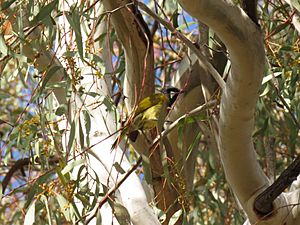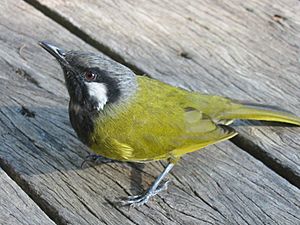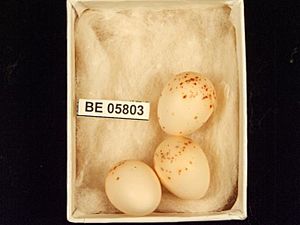White-eared honeyeater facts for kids
Quick facts for kids White-eared honeyeater |
|
|---|---|
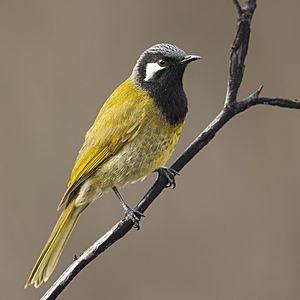 |
|
| Conservation status | |
| Scientific classification | |
| Genus: |
Nesoptilotis
|
| Species: |
leucotis
|
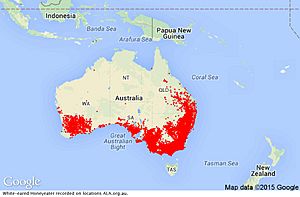 |
|
| Range map of the white-eared honeyeater (Nesoptilotis leucotis) | |
| Synonyms | |
|
Lichenostomus leucotis |
|
The white-eared honeyeater (Nesoptilotis leucotis) is a medium-sized honeyeater bird found in Australia. It belongs to a large bird family called Meliphagidae. This family includes honeyeaters and Australian chats. There are about 190 known species in this family, and about half of them live in Australia. This makes them the most diverse bird family in Australia. White-eared honeyeaters are easy to spot because of their olive-green body, black head, and a clear white patch near their ear.
Contents
About Its Name and Family Tree
The white-eared honeyeater was first described by an English bird expert named John Latham in 1801. He first called it Turdus leucotis. Over time, its name changed a few times. It was once known as Lichenostomus leucotis.
Scientists later used special tests to study the birds' DNA. These tests showed that the white-eared honeyeater should be in a different group, or genus, called Nesoptilotis. Before this, it was in the Lichenostomus genus. The tests also showed that the white-eared honeyeater is a close relative of the yellow-throated honeyeater (N. flavicollis), which lives in Tasmania.
Different Types of White-eared Honeyeaters
There are two main types, or subspecies, of the white-eared honeyeater.
- The first type, Nesoptilotis leucotis leucotis, lives in eastern Australia. You can find it from central Queensland down through New South Wales and Victoria to southeastern South Australia.
- The second type, N. l. novaenorciae, lives in southwestern Western Australia and the Eyre Peninsula in South Australia.
What Does the White-eared Honeyeater Look Like?
The white-eared honeyeater has an olive-green color on its upper and lower body. Its wings and tail are a mix of brown, yellow, and olive. The top of its head is dark grey with black stripes. Its cheeks and throat are black, and it has a clear white patch covering its ears.
Its eyes can be red or brown (if it's a young bird). Its beak is black, and its legs are dark grey. This honeyeater is a medium-sized bird, usually about 19 to 22 centimeters (7.5 to 8.7 inches) long. Male and female white-eared honeyeaters look the same. They weigh about 20 grams (0.7 ounces) and their beaks are about 17 millimeters (0.7 inches) long.
Its Voice and Calls
The white-eared honeyeater has a deep, soft, and slightly metallic voice. It makes sounds like chwok, chwok, chwok-whit, and kwitchu, kwitchu. It can also make a very sharp, scratchy, metallic chwik! sound.
Where Do White-eared Honeyeaters Live?
White-eared honeyeaters prefer to live in forests, woodlands, heathlands, and dry scrublands. They especially like places with eucalyptus trees, rough bark, and a layer of shrubs. The tree canopy gives them nectar in spring, and the bark provides insects all year. The shrubs are important for building nests and finding shelter.
These birds like older plants with lots of undergrowth. They can live in many different types of forests and woodlands, and even in small patches of trees. However, they do not like areas that are very damaged, have been recently burned, or have very few shrubs.
Different Groups Across Australia
Scientists recognize four main groups, or races, of N. leucotis.
- The leucotis race is found in eastern Australia, from Victoria to central Queensland. Birds on the eastern, coastal side of the Great Dividing Range have bright green upper parts and light greenish-yellow bellies. Birds on the western, inland side are a duller olive color and are slightly smaller.
- The novaenorciae race lives in Western Australia. This group is about 20% smaller than the leucotis race. Even though they look similar, they have important genetic differences.
- The schoddei race is found in the mallee woodlands of the Eyre Peninsula in South Australia.
- The fourth race, thomasi, lives on Kangaroo Island in South Australia.
Some white-eared honeyeaters, especially those in dry areas and the Mallee, and all of the novaenorciae race, do not need a shrub layer in their habitat.
White-eared Honeyeater Behavior
White-eared honeyeaters usually live alone. Sometimes, you might see them in small family groups. They can stay in one place, move around a lot, or travel short distances depending on the season.
Reproduction and Life Cycle
White-eared honeyeaters build nests and lay eggs from July to March. Their nest is shaped like a cup and is built low in a small shrub, fern, or tall grass, usually between 0.5 to 5 meters (1.6 to 16 feet) high. They make the nest from dry grass, thin stems, and strips of bark, holding it together with spiderwebs. The inside of the nest is soft, lined with plant material, down, feathers, hair, or fur. They are known to pluck fur and hair from animals like kangaroos, wallabies, and even humans or farm animals.
White-eared honeyeaters create their own areas, or territories, especially in winter when food is harder to find. They usually lay 2 or 3 oval-shaped eggs. The eggs are white with brown spots at the wider end and measure about 21 by 15 millimeters (0.8 by 0.6 inches). Both parents work together to raise their chicks.
We don't know exactly how long white-eared honeyeaters live. However, many other honeyeater species in Australia live for about 10 to 15 years. It's likely that the white-eared honeyeater lives for a similar amount of time.
Food and Feeding Habits
White-eared honeyeaters eat both nectar (sweet liquid from flowers) and insects. While they are often thought of as nectar-eaters, they eat just as many insects. They mostly eat nectar in spring and summer (August to December). For the rest of the year, they switch to eating insects.
They actively search for insects on tree trunks and branches. They prefer trees with soft, peeling bark, where insects might be hiding. They mostly collect termites and spiders. They also eat lerp and honeydew, which are sugary substances made by some insects. When they are looking for food, they search very carefully, finding about one insect every 5 seconds. This fast way of eating suggests that the insects they find might not have a lot of nutrients.
Other birds that only eat nectar or only eat insects often compete with white-eared honeyeaters for the best food. This means white-eared honeyeaters sometimes have to find other food sources, like smaller insects or those that are good at hiding. The yellow-faced honeyeater (Caligavis chrysops) eats similar foods. Sometimes, yellow-faced honeyeaters act aggressively towards white-eared honeyeaters.
How Are They Protected?
Even though the number of white-eared honeyeaters is decreasing, they are found over a very large area. Because of this, they are listed as a species of least concern on the IUCN Red List. This means they are not currently in danger of disappearing.
However, there are still threats to the white-eared honeyeater. These include damage to their habitat, bushfires, and the loss of the important shrub layer where they live.
See also
 In Spanish: Mielero orejiblanco para niños
In Spanish: Mielero orejiblanco para niños



